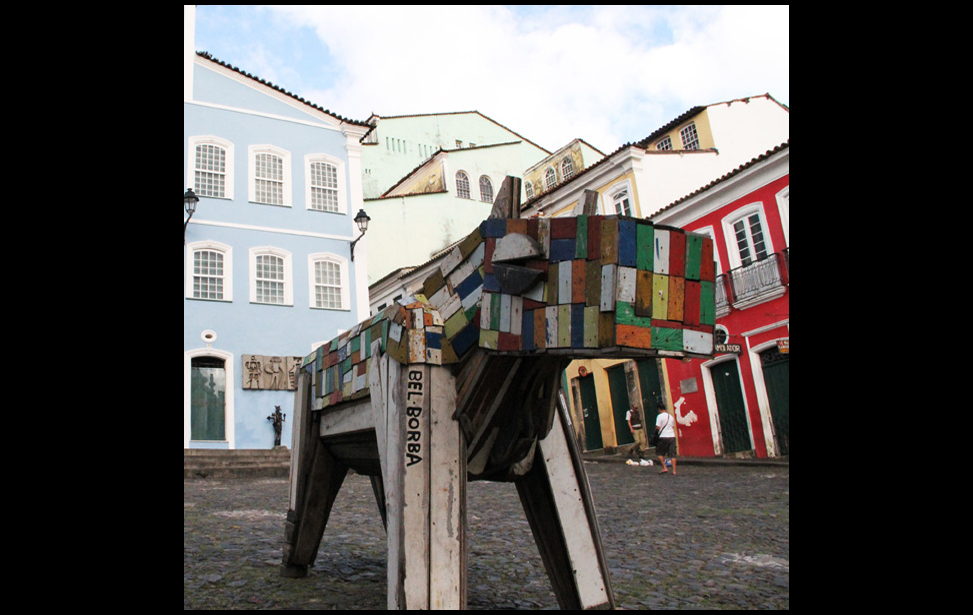Brazilian Artist Bel Borba Arrives Aqui
NEW YORK, NY -- America needs a Bel Borba. That's an unintended take-away from Burt Sun and André Costanini's documentary, Bel Borba Aqui, (see photo 1) about the Brazilian street artist dubbed “The People’s Picasso.”
And now, in an unabashedly gratifying tie-in, Borba has come to New York. The brief is to make a new ephemeral artwork each day for a month, captured by the filmmakers in a video diary to be shown at Times Square on October 14. It's all part of the Crossing the Line Festival, which coincides with the stateside release of Bel Borba Aqui.
This opioid of a film follows crinkle-eyed, mustachioed Borba (as seen photo 2) as he bedecks whatever is left of grey surfaces in Salvador, Bahia. And by all appearances, his 35-year orgy of color and wit has blazoned the city with an astonishing collection of public art.
Borba sees rhinos where we see wood heaps (as seen in photo 3). The hulk of a neglected edifice becomes a portrait gallery (as seen in photo 4). Alleys turn into mosaics of lions, turtles and fish (as seen in photo 5). He alters his world just as “you can transform your destiny,” the 50-something creator muses on camera. Whether laboring in solitude or rallying street life, he goes about his happy compulsion and buoys the seaside community along with him. What fellow Salvadoran Carlinhos Brown is to music, Borba is to visual art.
Intriguingly, all is not samba. In one of the film’s most poignant scenes, Borba constructs a towering Christmas tree out of Coke bottles filled with water and poems by Brazilian abolitionist Castro Alves. Subverting the commercial crowd-pleaser with this message-in-a-bottle allusion to a “cry for help,” the artist reveals a somber side that adds yet another active ingredient to Sun and Costantini’s filmed cure for the sensory deprived.
thalo caught up with Brazil’s indefatigable creative force on day seven of his New York mission, as he was affixing a beak to a utility rig on Roosevelt Island.
thalo: If you could leave a permanent mark on the City, what would it be?
Bel Borba: I´d make floating sculptures around Manhattan. They'd be from old plastic or found steel pieces or maybe floating chord.
th: Why do you prefer recycled materials?
BB: It's like alchemy, the capacity of changing something. You try to valorize something that deserved attention but was nothing.
th: How has your art transformed Salvador?
BB: The best change is that it's made people happier. Even if you create a cruel reflection, art can humanize a city. The only man-made thing that's as exuberant as nature is art.
th: In the film, your underwater metal sculpture becomes a habitat for sea life. What's art and what's nature?
BB: I wanted a new scheme. You saw how life restarts, but it took too long and the barnacles were dying.
th: You were creating in time. What is time for you? Please explain your onscreen comment, “You can change the moment to what you have in your mind.”
BB: Time is solid. This moment is repeated in all directions. I´m trying to inscribe myself inside the block. Aqui.
Photo credits:
Photo 1: Bel Borba Aqui Poster. Photo courtesy of Burt Sun.
Photo 2: Bel Borba. Photo courtesy of Burt Sun.
Photo 3: Rhino. Photo courtesy of Burt Sun.
Photo 4: Abandoned Building. Photo courtesy of Burt Sun.
Photo 5: Fish Mural. Photo courtesy of Burt Sun.












